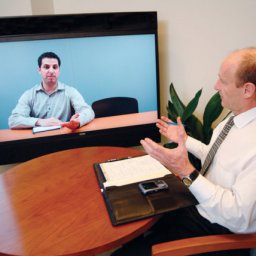Original Post by Dennis Collins

According to a recent Visual Networking Index produced, video already represents
64 percent of all Internet traffic, a proportion that will swell to 80 percent by 2019.
Talk us about your video conferencing needs.
Of course, video conferencing is riding this digital wave, too. A forecast by market analysis firm IDC that predicts the video-as-a-service (VaaS) market will see a compound annual growth rate of more than 25 percent by 2018.
Video Conferencing Popularity due to Ability to Tell a Story
Why is video so hot? Because video is a powerful means of storytelling, as Susan Weinschenk explains in her “Brain Wise” column for Psychology Today:
“Everyone likes stories. We like to listen to stories, read stories, watch stories (movies, TV, theatre) and tell stories. In fact, stories are our normal mode of information processing. Stories are so normal to us that we don’t even stop to think about why that is.”
This is why our consumption of digital video is rising so fast—among consumers and business people alike. Consider these stats from the infographic “2015: The year of video marketing”:
- 65 percent of video viewers watch more than three quarters of a clip.
- 75 percent of “business executives” watch work-related videos at least weekly, and more than half (54 percent) of “senior executives” share work-related videos at least weekly.
- Overall, eight in every 10 senior executives surveyed say they watch more online video today than they did a year ago.
 How to Prepare for Your Shot at Video Conferencing Storytelling
How to Prepare for Your Shot at Video Conferencing Storytelling
So, each of us better be ready for our turn in front of the webcam because video conferencing is coming soon to a meeting near you. Easy enough to do, right? As it turns out, performing well on video shares a lot of the same techniques as effective public speaking but also has a few counterintuitive angles that could make or break you.
Let’s start with the basics. Forget all those jokes about showing up for a video conference with suit and tie on top and pajamas on the bottom. You need to prepare for your spot on video the same way you would for a long speech in front of a crowded auditorium. Why? Because most conferencing systems have options to webcast and record, which means your performance could be broadcast via the Internet to audiences far beyond the current conference room—now and far into the future.
In her “Survival Guide” for public speaking, blogger Megan Ingenbrandt advises these three mental, physical and tactical preparations:
1. Rehearse Your Messaging and/or Presentation
Ever try to read slides while maintaining eye contact with a webcam lens? Instead, use a note card with a few key points on it. Place it in front of you—not to the side. This is so you won’t be tempted to turn away from that lens—and your audience.
2. Start Early & Check Your Technology
Talk us about your video conferencing needs.
How many times have you heard speakers doing sound checks before a show? How many lighting checks have you witnessed at conferences? Take the time to do the equivalent with your conferencing equipment—audio and video, software and hardware.
 3. Video Tech Can Glitch, Make a Plan B
3. Video Tech Can Glitch, Make a Plan B
Glitches will happen. Internet service may flutter through no one’s fault. And notes may go missing despite your best-laid plans. That’s okay. How you recover is the key, especially on video. One reason video is so popular is the personal connection the medium can create. We’ve all been there—or will be soon, if statistics are any indication. The fact your audience can see you can generate sympathy and support. But to minimize risk, send your presentation and/or notes to someone else involved in the meeting ahead of time. Whether the person is on-site or at another remote location, you’ll have an understudy.
Above all, when your time on video comes, remember to be you. Communications coach Marc Lemezma believes the secret to public speaking of all kinds is authenticity, what he calls that “mysterious mix of character, honesty and rapport that only comes from being true to oneself.”
Talk us about your video conferencing needs.



